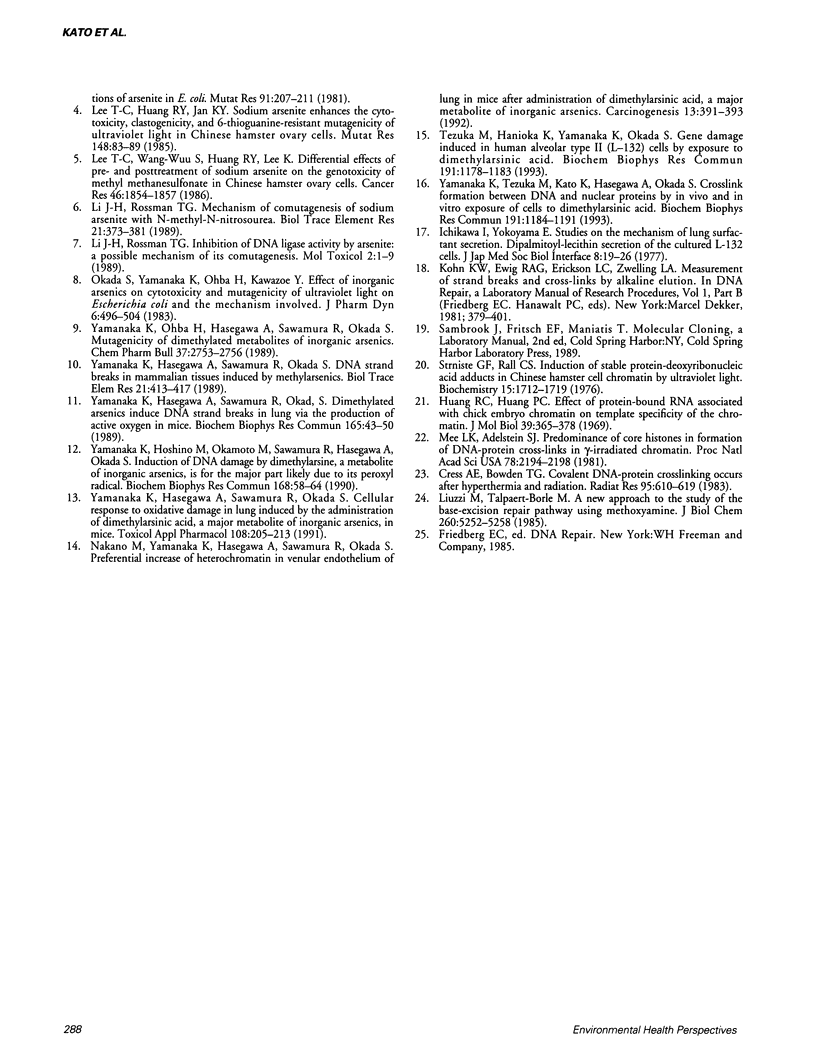Abstract
Gene damage in cultured human alveolar (L-132) cells induced by exposure to dimethylarsinic acid (DMAA), a major metabolite of inorganic arsenics in mammals, was studied. DNA single-strand breaks and DNA-protein cross-links were induced by the treatment of L-132 cells with 10 mM DMAA. These kinds of damage appeared at 8 hr after start of exposure to DMAA. As regards DNA-protein cross-links, the DNA was found to bind not only to core histone proteins but also linker histone (H1) and nonhistone proteins. Furthermore, the cross-links were formed by the binding to serine or threonine residues of H1 or nonhistone proteins through phosphate moieties of the DNA. The induction of the alkali-labile sites in DNA in DMAA-treated L-132 cells was observed prior to that of DNA single-strand breaks and DNA-protein cross-links. As one of the alkali-labile sites in DNA, we estimated apurinic/apyrimidinic (AP) sites in DNA. The present study suggests that the DNA single-strand breaks and DNA-protein cross-links induced by the treatment of L-132 cells with DMAA occurred via the formation of AP sites in the DNA and that the DNA-protein cross-links were produced by a Schiff-base reaction between amino groups of nuclear proteins and aldehyde groups of AP sites in the DNA and the DNA single-strand breaks, by a beta-elimination reaction on AP sites in the DNA.
Full text
PDF



Images in this article
Selected References
These references are in PubMed. This may not be the complete list of references from this article.
- Cress A. E., Bowden G. T. Covalent DNA-protein crosslinking occurs after hyperthermia and radiation. Radiat Res. 1983 Sep;95(3):610–619. [PubMed] [Google Scholar]
- Huang R. C., Huang P. C. Effect of protein-bound RNA associated with chick embryo chromatin on template specificity of the chromatin. J Mol Biol. 1969 Jan;39(2):365–378. doi: 10.1016/0022-2836(69)90323-4. [DOI] [PubMed] [Google Scholar]
- Lee T. C., Huang R. Y., Jan K. Y. Sodium arsenite enhances the cytotoxicity, clastogenicity, and 6-thioguanine-resistant mutagenicity of ultraviolet light in Chinese hamster ovary cells. Mutat Res. 1985 Jan-Feb;148(1-2):83–89. doi: 10.1016/0027-5107(85)90210-6. [DOI] [PubMed] [Google Scholar]
- Lee T. C., Wang-Wuu S., Huang R. Y., Lee K. C., Jan K. Y. Differential effects of pre- and posttreatment of sodium arsenite on the genotoxicity of methyl methanesulfonate in Chinese hamster ovary cells. Cancer Res. 1986 Apr;46(4 Pt 1):1854–1857. [PubMed] [Google Scholar]
- Li J. H., Rossman T. G. Inhibition of DNA ligase activity by arsenite: a possible mechanism of its comutagenesis. Mol Toxicol. 1989 Winter;2(1):1–9. [PubMed] [Google Scholar]
- Li J. H., Rossman T. G. Mechanism of comutagenesis of sodium arsenite with n-methyl-n-nitrosourea. Biol Trace Elem Res. 1989 Jul-Sep;21:373–381. doi: 10.1007/BF02917278. [DOI] [PubMed] [Google Scholar]
- Liuzzi M., Talpaert-Borlé M. A new approach to the study of the base-excision repair pathway using methoxyamine. J Biol Chem. 1985 May 10;260(9):5252–5258. [PubMed] [Google Scholar]
- Mee L. K., Adelstein S. J. Predominance of core histones in formation of DNA--protein crosslinks in gamma-irradiated chromatin. Proc Natl Acad Sci U S A. 1981 Apr;78(4):2194–2198. doi: 10.1073/pnas.78.4.2194. [DOI] [PMC free article] [PubMed] [Google Scholar]
- Nakano M., Yamanaka K., Hasegawa A., Sawamura R., Okada S. Preferential increase of heterochromatin in venular endothelium of lung in mice after administration of dimethylarsinic acid, a major metabolite of inorganic arsenics. Carcinogenesis. 1992 Mar;13(3):391–393. doi: 10.1093/carcin/13.3.391. [DOI] [PubMed] [Google Scholar]
- Okada S., Yamanaka K., Ohba H., Kawazoe Y. Effect of inorganic arsenics on cytotoxicity and mutagenicity of ultraviolet light on Escherichia coli and the mechanism involved. J Pharmacobiodyn. 1983 Jul;6(7):496–504. doi: 10.1248/bpb1978.6.496. [DOI] [PubMed] [Google Scholar]
- Strniste G. F., Rall S. C. Induction of stable protein-deoxyribonucleic acid adducts in Chinese hamster cell chromatin by ultraviolet light. Biochemistry. 1976 Apr 20;15(8):1712–1719. doi: 10.1021/bi00653a019. [DOI] [PubMed] [Google Scholar]
- Tezuka M., Hanioka K., Yamanaka K., Okada S. Gene damage induced in human alveolar type II (L-132) cells by exposure to dimethylarsinic acid. Biochem Biophys Res Commun. 1993 Mar 31;191(3):1178–1183. doi: 10.1006/bbrc.1993.1341. [DOI] [PubMed] [Google Scholar]
- Yamanaka K., Hasegawa A., Sawamura R., Okada S. Cellular response to oxidative damage in lung induced by the administration of dimethylarsinic acid, a major metabolite of inorganic arsenics, in mice. Toxicol Appl Pharmacol. 1991 Apr;108(2):205–213. doi: 10.1016/0041-008x(91)90111-q. [DOI] [PubMed] [Google Scholar]
- Yamanaka K., Hasegawa A., Sawamura R., Okada S. DNA strand breaks in mammalian tissues induced by methylarsenics. Biol Trace Elem Res. 1989 Jul-Sep;21:413–417. doi: 10.1007/BF02917283. [DOI] [PubMed] [Google Scholar]
- Yamanaka K., Hasegawa A., Sawamura R., Okada S. Dimethylated arsenics induce DNA strand breaks in lung via the production of active oxygen in mice. Biochem Biophys Res Commun. 1989 Nov 30;165(1):43–50. doi: 10.1016/0006-291x(89)91031-0. [DOI] [PubMed] [Google Scholar]
- Yamanaka K., Hoshino M., Okamoto M., Sawamura R., Hasegawa A., Okada S. Induction of DNA damage by dimethylarsine, a metabolite of inorganic arsenics, is for the major part likely due to its peroxyl radical. Biochem Biophys Res Commun. 1990 Apr 16;168(1):58–64. doi: 10.1016/0006-291x(90)91674-h. [DOI] [PubMed] [Google Scholar]
- Yamanaka K., Ohba H., Hasegawa A., Sawamura R., Okada S. Mutagenicity of dimethylated metabolites of inorganic arsenics. Chem Pharm Bull (Tokyo) 1989 Oct;37(10):2753–2756. doi: 10.1248/cpb.37.2753. [DOI] [PubMed] [Google Scholar]
- Yamanaka K., Tezuka M., Kato K., Hasegawa A., Okada S. Crosslink formation between DNA and nuclear proteins by in vivo and in vitro exposure of cells to dimethylarsinic acid. Biochem Biophys Res Commun. 1993 Mar 31;191(3):1184–1191. doi: 10.1006/bbrc.1993.1342. [DOI] [PubMed] [Google Scholar]



